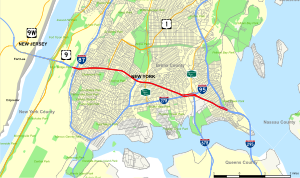Cross Bronx Expressway | |
|---|---|
 Map of the Bronx in New York City with Cross Bronx Expressway highlighted in red | |
| Route information | |
| Length | 6.83 mi (10.99 km) |
| Existed | 1955[1]–present |
| Component highways | |
| Major junctions | |
| West end | |
| East end | |
| Location | |
| Country | United States |
| State | New York |
| Highway system | |
The Cross Bronx Expressway is a major freeway in the New York City borough of the Bronx. It is mainly designated as part of Interstate 95 (I-95), but also includes portions of I-295 and U.S. Route 1 (US 1). The Cross Bronx begins at the eastern approach to the Alexander Hamilton Bridge over the Harlem River. While I-95 leaves at the Bruckner Interchange in Throgs Neck, following the Bruckner Expressway and New England Thruway to Connecticut, the Cross Bronx Expressway continues east, carrying I-295 to the merge with the Throgs Neck Expressway near the Throgs Neck Bridge. Though the road goes primarily northwest-to-southeast, the nominal directions of all route numbers west of the Bruckner Interchange are aligned with the northbound route number going southeast, and the southbound route number going northwest.
The Cross Bronx Expressway was conceived by Robert Moses and built between 1948 and 1972. It was the first highway built through a crowded urban environment in the United States; the most expensive mile of road ever built to that point is part of the Cross Bronx, costing $40 million (equivalent to $454,956,522 in 2023). At one point during construction, Moses' crews had to support the Grand Concourse (a major surface thoroughfare), a subway line[a] and several elevated train lines[b] while the expressway was laboriously pushed through. The highway experiences severe traffic problems, and its construction has been blamed for negatively affecting a number of low-income neighborhoods in the South Bronx. Most Bronxites consider the Cross Bronx Expressway the defining border between the North and the South Bronx.[2]
Cite error: There are <ref group=lower-alpha> tags or {{efn}} templates on this page, but the references will not show without a {{reflist|group=lower-alpha}} template or {{notelist}} template (see the help page).
